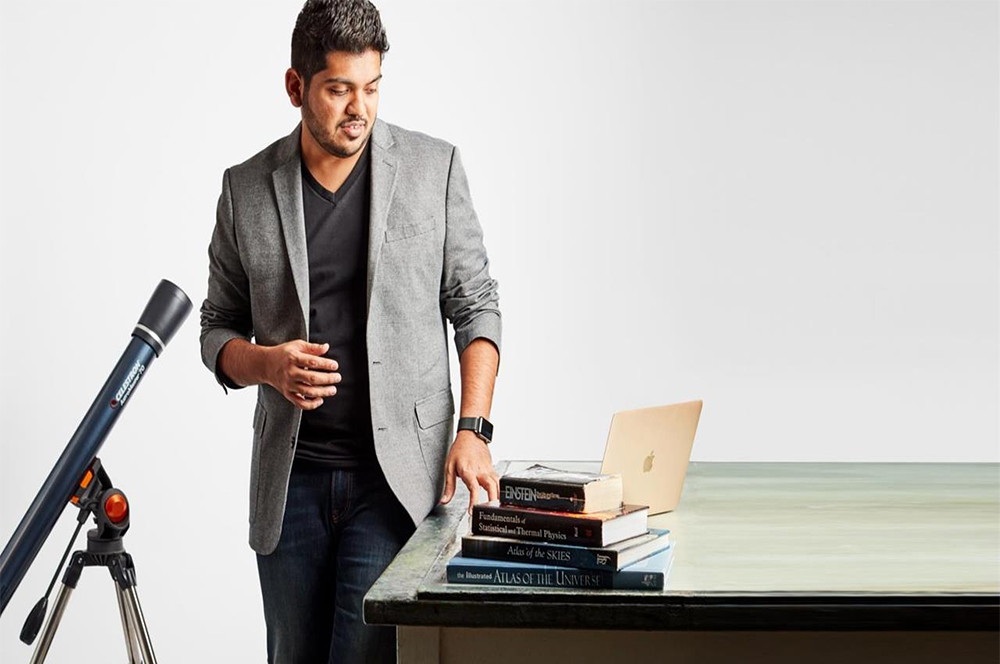Karan Jani’s obsession with black holes sparked when he picked up a secondhand copy of Stephen Hawking’s A Brief History of Time. Three years later, he found himself having lunch with the famed physicist at the Black Hole Bistro at the Perimeter Institute for Theoretical Physics in Canada, where Jani was a research fellow. I caught up with the laid-back 28-year-old on a recent Saturday, connecting via Skype from his parents’ home in Vadodara, a city in the state of Gujarat, India. A newly minted Ph.D. graduate from Georgia Tech, Jani was home for a break, he says, putting air quotes around “break” since he’d had hardly any time to himself or with his family. Instead, he’d been giving back-to-back lectures at colleges around the country, talking to students about careers in science.
In 2015, Jani was a key member of the team at LIGO — Laser Interferometer Gravitational-Wave Observatory — that was the first to discover gravitational waves (cosmic ripples in the space-time fabric), proving that Einstein was right about relativity. As a regular kid from a middle-class family in western India, Jani is the epitome of “small-town boy makes it big.” But in a country where science education is mostly about memorizing formulas and definitions and earning the highest marks, Karan Janis are rare — and he’s determined to change that.
"WE [INDIA] COULD GO TO MARS, BUT THAT STILL DOESN’T TRICKLE DOWN TO EDUCATION."
At LIGO, Jani explains that his role “was to look for black holes 50 to 1,000 times the size of the sun,” which create gravitational waves when they collide. Turns out two such black holes collided nearly 1.3 billion years ago — just in time for the resulting ripples to reach the earth in September 2015 when Jani and his colleagues were studying them. The discovery grabbed headlines, Jani received the Special Breakthrough Prize in Fundamental Physics, Prime Minister Narendra Modi asked to meet him, and Forbes named him to its 2017 list of the 30 most influential scientists under 30.
Just 10 years ago though, Jani, a freshman at a small college in Gujarat, was on the verge of flunking his exams. Growing up in Vadodara, he wasn’t a particularly good student. “I would look at the night sky and wonder, why are all those stars there?” he recalls. This and other abstract questions would bug him all day and keep him up at night. By the middle of that terrible year in Gujarat, Jani knew he wanted something different: a formal training in astronomy.
But he couldn’t find the astronomy courses he was after in India, so he enrolled at Penn State University, double majoring in physics and astronomy and minoring in mathematics. Dr. Ravi Kumar Kopparapu, who supervised Jani as a research assistant, remembers him as a curious, bright-eyed kid. “He never hesitated to ask questions and was always looking for something new to do in his field,” he says. Roughly 80 percent of PSU’s astronomy majors drop out; Jani was one of just four candidates to graduate.
After graduation, his budding interest in gravitational waves led him to LIGO-India — a proposal to build the world’s third gravitational-waves observatory in India that had been mired in bureaucracy for years due to lack of funding. It was 2011, Jani says, when proving the existence of these cosmic ripples was like searching for aliens. “But [a career in] science is like golf,” he adds — there’s only so much you can control. So Jani took a chance.
Which led to his blockbuster discovery and a meeting with India’s prime minister, who urged the astrophysicist to share his story with local students. But early into his tour of universities, he was hit by a discouraging realization: “We [India] could go to Mars, but that still doesn’t trickle down to education.” On one end are ”exam toppers,” kids who ace their college-entrance exams and get photographed by local newspapers, and on the other, millions of students warehoused in smaller colleges who receive neither career guidance nor proper practical training. This dichotomy, says Jani, “disturbed and engaged” him.
The entrance exam system — a Hunger Games–like race for admission to India’s top colleges — troubles Jani. “I learned physics by being wrong 100 times and taking the time to figure out why I was wrong each time,” he says. By contrast, a system structured on memorizing tips and tricks to guess the right answer in under a minute makes no sense to him — and undermines meaningful learning.
Dr. Dheeraj Sanghi, a professor at the Indian Institute of Technology (IIT) in Kanpur, agrees that the entrance exam system puts an outsize emphasis on marks. But getting rid of it isn’t so simple, he says. “The alternative would be a more subjective evaluation, but in India, that is likely to be politicized and influenced by bribes,” he says. The other challenge in making the process more subjective is that it would make the institutes more vulnerable to lawsuits from people challenging their assessment, he says. One innovative idea is what the Indian Institute of Information Technology in Delhi follows, where, in addition to exam scores, extracurricular activities carry weight. “For instance, if you have a high chess rating or if you’ve represented your state in a sport at the national level, you’ll get a certain number of bonus marks,” he says.
Still, getting the best science education means getting into the top institutes like the 16 IITs. Seats are few; competition is cutthroat. But Jani thinks the solution might be to decentralize India’s education system. “Analyze each state’s needs and create research centers geared toward innovation in those states,” he says. Gujarat, for example, wouldn’t necessarily have a physics institute, but it would have a seed technology research center to support innovations in agriculture, a vital industry in that state. This is now the question keeping the stargazer up at night.

